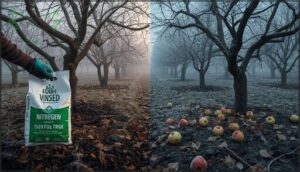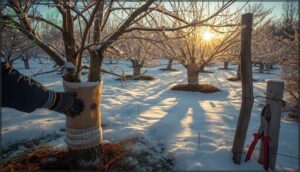This site is supported by our readers. We may earn a commission, at no cost to you, if you purchase through links.
Last winter, a friend lost three young apple trees to rabbits that gnawed through the bark in a single hungry week. The trees looked fine from a distance, but underneath those protective wraps she’d forgotten to check, the damage had already severed the lifeline between roots and branches.
Fruit tree winter protection isn’t just about surviving cold snaps—it’s about defending against an entire season of threats that work quietly beneath snow cover and frozen soil. Rodents seeking food, temperature swings cracking bark, and roots struggling through freeze-thaw cycles can undo years of careful cultivation.
Understanding how these dangers operate and when they strike most helps you build defenses that actually hold through March.
Table Of Contents
- Key Takeaways
- Why Fruit Trees Need Winter Protection
- Shielding Trunks From Animal Damage
- Insulating Roots and Soil for Cold Weather
- Additional Methods to Prevent Winter Injury
- Best Practices for Sustainable Winter Care
- Frequently Asked Questions (FAQs)
- What temperature should I cover my fruit trees?
- What should I spray my fruit trees with in winter?
- Can fruit trees survive a freeze?
- Which fruit tree can survive winter?
- How to protect fruit trees from extreme heat?
- Do I need to protect my fruit trees in winter?
- How to protect fruit trees from freezing?
- How do you treat fruit trees in the winter?
- Can you spray water on fruit trees to prevent freezing?
- How to protect fruit trees from heavy snow?
- Conclusion
Key Takeaways
- Winter protection for fruit trees addresses multiple threats, including rodent damage that girdles bark and disrupts water flow, temperature swings that cause bark splitting and sunscald, and root stress from freeze-thaw cycles that can undo years of cultivation.
- Effective trunk defense requires hardware cloth with ¼-inch mesh installed at least 24 inches high or spiral tree wraps applied before the first freeze, both creating barriers against gnawing pests while allowing proper air circulation.
- Root insulation through 3-6 inch layers of organic mulch like bark or straw stabilizes soil temperature and retains moisture, but late-season nitrogen fertilization and fall pruning should be avoided since they trigger vulnerable new growth before frost arrives.
- Successful winter care combines proactive measures like clearing fallen leaves and fruit debris to eliminate pest habitat with regular mid-season monitoring for bark damage, maintaining consistent soil moisture, and using proper pruning techniques to remove compromised wood in early spring.
Why Fruit Trees Need Winter Protection
Winter brings a mix of challenges for fruit trees, from hungry animals to harsh weather. Protecting your trees now can save you trouble and heartbreak come spring.
Here are some practical ways to shield them when the cold sets in.
Common Winter Threats to Fruit Trees
Winter damage comes in many forms, each with its own risks for fruit trees. Wildlife bark stripping by rabbits and rodents, cold injury thresholds from sudden temperature drops, sunscald bark damage, and trunk bark splitting all threaten young trees.
Rodent feeding habits and girdling near the soil line disrupt water flow, making your trees vulnerable to disease and dieback before spring arrives.
A tree’s cold hardiness levels can fluctuate throughout the winter season.
Effects of Wildlife and Rodent Damage
When rabbits, voles, and mice gnaw at bark, they cause girdling effects that block water and nutrients, often killing young trees before spring. Yield reduction follows, along with real economic impact—orchards lose thousands to wildlife damage each year.
Rabbits and rodents gnawing bark can girdle young trees, blocking nutrients and costing orchards thousands in lost yields each winter
Tree vulnerability peaks in winter, making rodent damage prevention a must if you want healthy, productive fruit trees next season. To prevent this, consider using plastic tree wraps on your trees.
Risks of Cold, Frost, and Sunscald
Animal damage isn’t the only worry—cold injury and frost damage can be just as destructive. Extreme temperature changes lead to root freezing, bark cracking, and sunscald effects, especially on southwest-facing trunks.
Preventing sun scald and winter injury means you should:
- Paint trunks with white latex.
- Mulch to insulate roots.
- Wrap trunks against frost damage.
Shielding Trunks From Animal Damage
Protecting your fruit tree trunks from hungry critters is simpler than it might seem. There are a handful of reliable ways to block rabbits, voles, and other pests from causing harm.
Let’s look at the most effective options for keeping your trees safe through winter.
Using Hardware Cloth and Tree Guards
Ever notice how young fruit trees seem like magnets for curious critters? Using hardware cloth with a ¼-inch mesh size creates a sturdy, long-lasting barrier, blocking gnawing pests while letting air circulate.
Guard installation at least 24 inches high shields against snow and deer. Paired with classic tree guards, this defense helps prevent sunscald and encourages sustainable health season after season.
Installing Spiral Tree Trunk Protector Wraps
For those aiming to boost winter tree care with preventative tree protection, installing spiral tree wraps is a smart investment. Early Installation Timing—just before the first freeze—helps guard against gnawing rodents. These wraps spiral snugly around the tree trunk, creating a barrier that discourages chewing and blocks entry at soil level.
Always check ventilation needs—the best wraps feature holes for airflow, reducing fungus risk. With a solid Wrap Lifespan and minimal fuss, tree wraps are effective for protecting fruit trees through harsh winters.
Proper Installation Techniques and Maintenance
A sound winter defense hinges on Guard Installation and correct Material Maintenance. For success, follow these steps:
- Place hardware cloth, tree tubes, or a rabbit and rodent fence around trunks, extending below ground.
- Overlap Burlap Wrapping with one-third coverage.
- Apply mulch with a clear trunk gap.
- Check wraps and tree guards often for displacement or damage, ensuring year-round Error Prevention.
Insulating Roots and Soil for Cold Weather
Roots are just as vulnerable to cold as anything above ground. The right layer of protection keeps your fruit trees healthy when the temperature drops.
Here’s what to look for when choosing how to insulate the roots and soil.
Mulching for Temperature Regulation
Think of mulch as your fruit tree’s winter blanket. A layer 3 to 6 inches deep keeps roots insulated from wild temperature swings and holds in precious soil moisture. Bark mulch stabilizes root temperature and boosts yield, while straw’s air pockets soften cold snaps.
Here’s how different options perform:
| Mulch Type | Insulation Properties |
|---|---|
| Bark Mulch | Stabilizes root temperature |
| Straw | Air pockets, cold protection |
| Grass Mulch | Regulates temperature swings |
| Bran | Greater moisture retention |
Choosing The Right Mulch Materials
Choosing between organic and inorganic mulch boils down to your goals and budget. Bark mulch and fallen leaves improve soil health and retain moisture; they’re cost-friendly and widely available. Inorganic versions last longer but add no nutrients.
Whether you use straw, pine needles, or gravel, keep your mulch 2–4 inches deep—enough for insulation without risking rot.
Avoiding Harmful Fall Amendments
Late fall is the wrong time for risky amendments. High nitrogen boosts growth right before frost bites, putting root hardening at risk. Compost or fresh manure can deliver more harm than help, as can poorly-timed lime.
Focus instead on pH balance and nutrient reserves, skip fall pruning, and clear fallen leaves and fruit debris to keep organic matter in check over winter.
Additional Methods to Prevent Winter Injury
Winter can throw a lot at your fruit trees, but a few extra steps will make a real difference. Beyond trunk protection and mulching, there are other ways to keep your trees healthy until spring.
Here’s what you can do next to make sure your trees stay safe through the cold months.
Reducing Habitat for Rodents and Pests
Want fewer rodents chewing your fruit trees? Brush pile removal, mowing cover crops, and regular leaf litter cleanup go a long way. Fence row maintenance and equipment yard clearing disrupt favorite hiding spots.
Habitat modification—removing fallen leaves and fruit debris—directly lowers pest numbers and keeps hungry critters at bay all winter, making prevention strategies more effective for healthier trees.
Proper Fall Watering Practices
Beyond clearing debris, your fruit tree needs proper fall watering practices to build root health before freeze-up. Check soil moisture weekly by digging four to six inches deep—if it’s dry, water deeply.
Overwatering risks root rot, especially during rainy stretches. As temperatures drop, reduce watering frequency but keep sessions deep, helping your fruit tree store nutrients and resist winter stress.
Best Practices for Sustainable Winter Care
Beyond the protective measures you’ve already put in place, a few smart habits can make the difference between a tree that limps through winter and one that springs back strong.
These practices focus on reducing stress, keeping pests at bay, and catching problems before they spiral.
Let’s walk through three straightforward steps that set your fruit trees up for long-term health.
Removing Debris and Fallen Leaves
When you clear fallen leaves and fruit debris from under your trees, you disrupt pest habitat reduction and prevent disease spore prevention. Over 60% of fungal infections start in overwintering leaf litter, so sustainable winter care begins with thorough cleanup.
Use debris removal tools like rakes or leaf vacuums, and always remove mummies to protect soil health impact while winterizing fruit trees effectively.
Avoiding Late-Season Fertilization and Pruning
Just as clearing debris sets the stage, your timing with fertilizers and pruning makes a big difference. Fertilizing after mid-summer or pruning techniques applied in late fall can trigger tender new growth that won’t survive the first freeze, causing dormancy disruption and weakening growth hardening.
Instead, follow these practices when winterizing fruit trees:
- Stop fertilizing by late summer to support nutrient uptake during dormant season preparation
- Schedule heavy pruning timing for late winter, avoiding fall pruning entirely
- Test your soil first to prevent unnecessary amendments
- Make regional adjustments based on local frost dates and climate patterns
Monitoring for Damage and Early Recovery Steps
Even with careful prep, winter can still surprise you. Start with bud dissection in early spring—green means healthy, brown signals frost damage.
Regular visual inspections catch wildlife damage and bark splitting before they worsen. Keep soil moisture consistent without waterlogging, and use proper pruning techniques to remove dead wood.
Tailor nutritional programs to recovery needs, supporting fruit tree health through the toughest season.
Frequently Asked Questions (FAQs)
What temperature should I cover my fruit trees?
You should cover your fruit trees when temperatures drop to 32°F or below, especially when blossoms or developing fruit are present, to prevent frost damage during freezing temperatures and cold weather events.
What should I spray my fruit trees with in winter?
You should apply dormant oil sprays to control overwintering pests, lime-sulfur for fungal diseases, and copper fungicide for bacterial infections.
Proper spray timing between late fall and early spring ensures effective tree protection.
Can fruit trees survive a freeze?
Like a bear in hibernation, dormant fruit trees can handle freezing temperatures below 20°F. However, as buds swell in spring, their cold hardiness factors weaken, making freeze survival rates plummet when frost strikes developing blossoms.
Which fruit tree can survive winter?
Your hardiness zone guides cultivar selection for winter survival. Cold-tolerant apples, pears, and plums thrive in zones 3-4 during dormancy periods, showing strong climate adaptation to freezing temperatures and harsh winter conditions for plants.
How to protect fruit trees from extreme heat?
Shield fruit trees from sun scald by painting trunks with white latex paint, which reflects heat.
Mulch stabilizes soil temperature, while shade solutions and deep watering strategies help trees withstand extreme temperature changes.
Do I need to protect my fruit trees in winter?
Yes, winter fruit tree protection depends on tree age, species hardiness, local climate, and previous damage. Young fruit trees under five years need trunk wraps and mulch. Resource availability and your region’s winter severity determine care intensity.
How to protect fruit trees from freezing?
Wrap trunks with burlap tree wraps or frost protection methods like fabric covers during freeze warning systems.
Proper winter watering tips before cold snaps help prevent frost cracks, while mulch insulates roots against harsh winter weather.
How do you treat fruit trees in the winter?
Treating fruit trees in winter means maintaining dormancy management through proper winter hydration, employing pest control measures, and protecting tree trunks from winter weather damage.
Prevention strategies include wound sealing and ensuring adequate snow protection around roots.
Can you spray water on fruit trees to prevent freezing?
Spraying water on fruit trees during frost can work, but it’s risky. Ice damage from heavy accumulation, system failures, and high water usage make this method effective only in specific environmental conditions with careful monitoring.
How to protect fruit trees from heavy snow?
Heavy snowfall is like a silent threat, weighing down branches until they snap.
Proper pruning maintains strong angles between 45 and 60 degrees, reducing branch breakage and trunk splitting risks while preventing winter scald and moisture-related damage.
Conclusion
Healthy roots need insulation, exposed trunks need barriers, and vulnerable bark needs defense—fruit tree winter protection works when you address each threat before it compounds. The steps aren’t complicated: wrap trunks before rodents arrive, mulch roots before the ground freezes, and clear debris before pests settle in.
Check your defenses mid-season, adjust what’s failing, and you’ll find spring growth emerging from trees that weathered the cold intact, not compromised.
- https://learn.orchardpeople.com/researching-fruit-trees-for-organic-growing-success
- https://pmc.ncbi.nlm.nih.gov/articles/PMC6695134/
- https://digitalcommons.unl.edu/cgi/viewcontent.cgi?article=1046&context=ewdcc3
- https://deerbusters.com/blog/agricultural-damage-by-wildlife
- https://ag.purdue.edu/department/btny/ppdl/potw-dept-folder/2021/rodent-damage-fruit-plants.html










